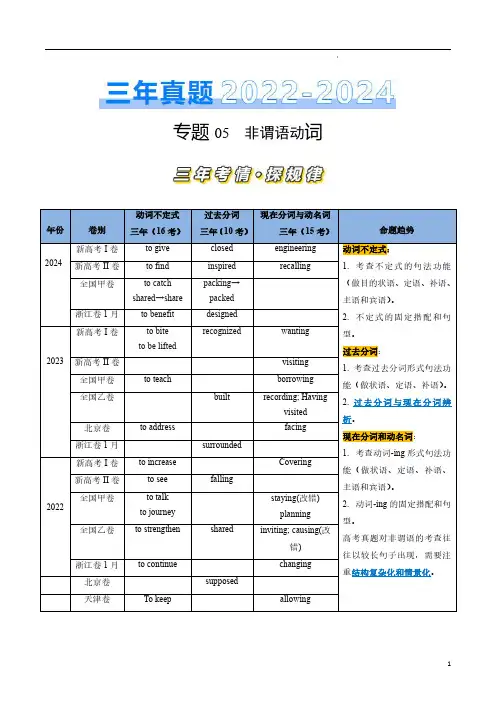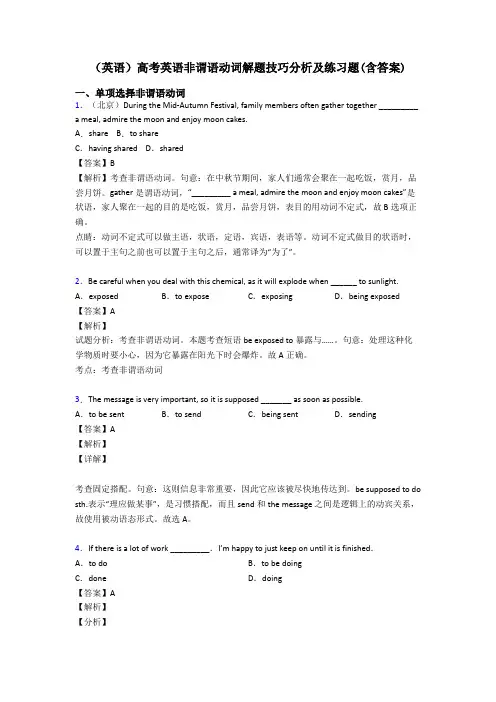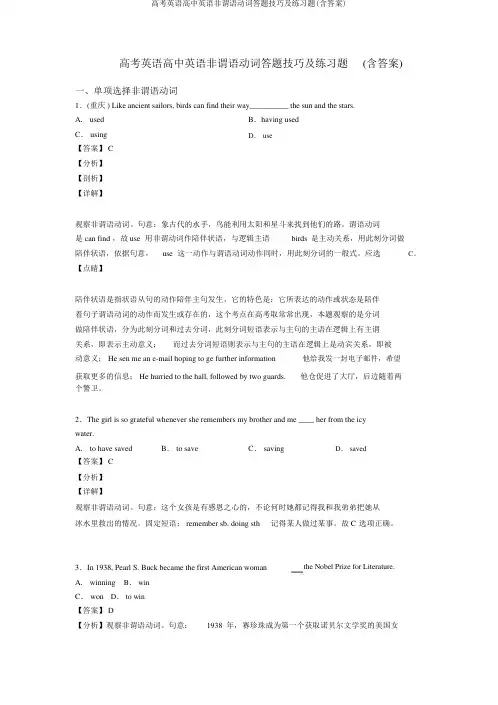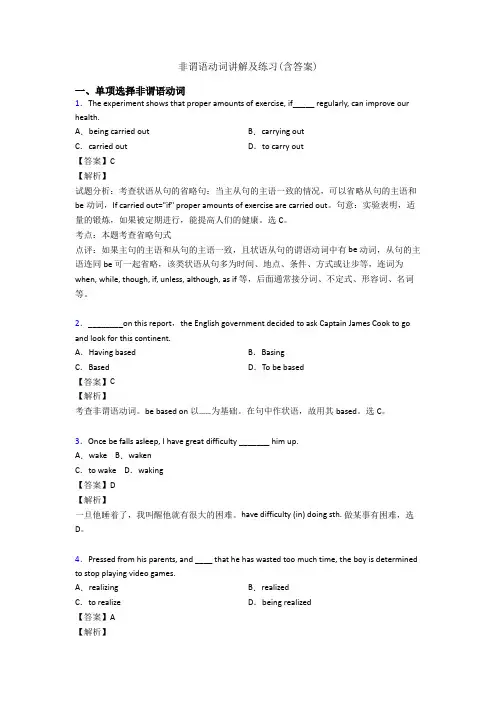非谓语动词讲解及高考题精选(含答案)
- 格式:doc
- 大小:117.50 KB
- 文档页数:13

2009年1.(全国卷I)The children all turned the famous actress as she entered the classroom.A. looked atB. to look atC. to looking atD. look at【答案】B【解析】句意:当那位著名的女演员进教室的时候,孩子们一下子都转过去看她。
不要把“to”和“turn”联系在一起理解为“turn to (转向,求助)”的词组,该词组中的“to”是介词。
本题是不定式作目的状语。
2.(全国卷I)Now that we’ve discussed our problem, are people happy with the decisionsA. takingB. takeC. takenD. to take 【答案】C【解析】句意:既然我们讨论了我们的问题,则人们满意所作的决定吗?The decisions和take之间是被动关系,故用过去分词。
3.(全国卷II)They use computers to keep the traffic smoothly.A. being runB. runC. to runD. running【答案】D【解析】这儿构成“keep sth. doing”固定用法。
现在分词作动词keep 的宾语补足语。
traffic与run之间是主动关系,所以用现在分词。
4.(北京卷)For breakfast he only drinks juice from fresh fruit ___ on his own farm.A. grownB. being grownC. to be grownD. to grow【答案】A【解析】fresh fruit与grow的关系是被动和完成,所以用过去分词做定语。
5.(北京卷)All of them try to use the power of the workstation ___ information in a more effective way.A. presentingB. presentedC. being presentedD. to present【答案】D【解析】通过句意可知要用不定式作状语表示原因。

专题05非谓语动词年份卷别动词不定式三年(16考)过去分词三年(10考)现在分词与动名词三年(15考)命题趋势2024新高考I卷to give closed engineering动词不定式:1.考查不定式的句法功能(做目的状语、定语、补语、主语和宾语)。
2.不定式的固定搭配和句型。
过去分词:1.考查过去分词形式句法功能(做状语、定语、补语)。
2.过去分词与现在分词辨析。
现在分词和动名词:1.考查动词-ing形式句法功能(做状语、定语、补语、主语和宾语)。
2.动词-ing的固定搭配和句型。
高考真题对非谓语的考查往往以较长句子出现,需要注重结构复杂化和情景化。
新高考II卷to find inspired recalling全国甲卷to catchshared→sharepacking→packed浙江卷1月to benefit designed2023新高考I卷to biteto be liftedrecognized wanting新高考II卷visiting全国甲卷to teach borrowing全国乙卷built recording;Havingvisited 北京卷to address facing浙江卷1月surrounded2022新高考I卷to increase Covering新高考II卷to see falling全国甲卷to talkto journeystaying(改错)planning全国乙卷to strengthen shared inviting;causing(改错)浙江卷1月to continue changing 北京卷supposed天津卷To keep allowing考点01动词不定式1.(2024年新高考I卷语法填空)These sepals open on warm days________(give)the inside plants sunshine and fresh air.【答案】to give【解析】考查非谓语动词。

(英语)高考英语非谓语动词解题技巧分析及练习题(含答案)一、单项选择非谓语动词1.(北京)During the Mid-Autumn Festival, family members often gather together _________ a meal, admire the moon and enjoy moon cakes.A.share B.to shareC.having shared D.shared【答案】B【解析】考查非谓语动词。
句意:在中秋节期间,家人们通常会聚在一起吃饭,赏月,品尝月饼。
gather是谓语动词,“_________ a meal, admire the moon and enjoy moon cakes”是状语,家人聚在一起的目的是吃饭,赏月,品尝月饼,表目的用动词不定式,故B选项正确。
点睛:动词不定式可以做主语,状语,定语,宾语,表语等。
动词不定式做目的状语时,可以置于主句之前也可以置于主句之后,通常译为“为了”。
2.Be careful when you deal with this chemical, as it will explode when ______ to sunlight. A.exposed B.to expose C.exposing D.being exposed【答案】A【解析】试题分析:考查非谓语动词。
本题考查短语be exposed to暴露与……。
句意:处理这种化学物质时要小心,因为它暴露在阳光下时会爆炸。
故A正确。
考点:考查非谓语动词3.The message is very important, so it is supposed _______ as soon as possible.A.to be sent B.to send C.being sent D.sending【答案】A【解析】【详解】考查固定搭配。
句意:这则信息非常重要,因此它应该被尽快地传达到。


高考英语高中英语非谓语动词答题技巧及练习题(含答案)一、单项选择非谓语动词1.(重庆 ) Like ancient sailors, birds can find their way__________ the sun and the stars.A. used B.having usedC. using D. use【答案】 C【分析】【剖析】【详解】观察非谓语动词。
句意:象古代的水手,鸟能利用太阳和星斗来找到他们的路。
谓语动词是 can find,故 use 用非谓动词作陪伴状语,与逻辑主语birds 是主动关系,用此刻分词做陪伴状语,依据句意,use 这一动作与谓语动词动作同时,用此刻分词的一般式。
应选C。
【点睛】陪伴状语是指状语从句的动作陪伴主句发生,它的特色是:它所表达的动作或状态是陪伴着句子谓语动词的动作而发生或存在的,这个考点在高考取常常出现,本题观察的是分词做陪伴状语,分为此刻分词和过去分词,此刻分词短语表示与主句的主语在逻辑上有主谓关系,即表示主动意义;而过去分词短语则表示与主句的主语在逻辑上是动宾关系,即被动意义; He sen me an e-mail hoping to ge further information他给我发一封电子邮件,希望获取更多的信息; He hurried to the hall, followed by two guards. 他仓促进了大厅,后边随着两个警卫。
2.The girl is so grateful whenever she remembers my brother and me ____ her from the icywater.A. to have saved B. to save C. saving D. saved【答案】 C【分析】【详解】观察非谓语动词。
句意:这个女孩是有感恩之心的,不论何时她都记得我和我弟弟把她从冰水里救出的情况。

高考英语非谓语动词及其解题技巧及练习题(含答案)一、单项选择非谓语动词1.Today there are more airplanes____ more people than ever before in the skies.A.carry B.carryingC.carried D.to be carrying【答案】B【解析】试题分析:考查现在分词作定语。
句意:现在比以前有有更多的飞机运送乘客。
此处airplane和carrying之间是主动关系,故用现在分词作定语。
故选B。
考点:考查现在分词作定语【名师点睛】非谓语动词的做题步骤1、判定是否用非谓语形式。
方法:看看句子中是否已有了谓语动词了;2、找非谓语动词的逻辑主语。
方法:非谓语动词的逻辑主语一般是句子的主语。
3、判断主被动关系。
方法:非谓语动词与其逻辑主语的主动还是被动关系。
4、判断时间关系。
方法:分析句子,看看非谓语动词所表示的动作发生在谓语动作之前、之后还是同时。
之前常用 done; 之后常用to do; 同时常用doing.从本题来看主句的主语airplanes与动词carry构成逻辑上的主动关系,因此用v.-ing形式作定语。
2.I had been betrayed by those who I trusted several times, ______ in a suspicious attitude towards everything and everyone.A.resulted B.having resulted C.resulting D.to result【答案】C【解析】【详解】考查非谓语做结果状语。
句意:我曾被我信任的人背叛过几次,导致我对每件事和每一个人都抱着怀疑的态度。
“result in...”为固定搭配,意为“导致”。
前一句“我曾被我信任的人背叛过几次”,导致后面的结果“我对每件事和每一个人都抱着怀疑的态度”。

高考英语五年真题(2019-2023年)专题汇总解析—非谓语动词一、2023年高考真题1.2023新高考全国Ⅰ卷To eat one, you have to decide whether ____37____ (bite) a small hole in it first, releasing the stream and risking a spill (溢出)...【答案】to bite【解析】考查非谓语动词。
句意:吃小笼包的时候,你必须要决定是先咬一个小口流出汤汁,还是把整个小笼包放进嘴里,让热汤在舌头上爆炸。
decide to do sth.“决定做某事”,用不定式作宾语,空处与后面to put并列作宾语,故填to bite。
2.2023新高考全国Ⅰ卷Shanghai may be the ____39____ (recognize) home of the soup dumplings but food historians will actually point you to the neighboring canal town of Nanxiang as Xiao long hao’s birthplace.【答案】recognized【解析】考查非谓语动词。
句意:上海可能是公认的小笼包之乡,但美食历史学家会告诉你,邻近的运河小镇南翔才是小笼包的发源地。
空格在名词home前面作定语,recognize与home是逻辑上动宾关系,需填过去分词recognized作定语,recognized“被公认的”也可以看作是形容词作定语。
故填recognized。
3.2023新高考全国Ⅰ卷Nanxiang aside, the best Xiao long bao have a fine skin, allowing them ____41____ (lift) out of the steamer basket ...【答案】to be lifted【解析】考查非谓语动词。

非谓语动词讲解及练习(含答案)一、单项选择非谓语动词1.The experiment shows that proper amounts of exercise, if_____ regularly, can improve our health.A.being carried out B.carrying outC.carried out D.to carry out【答案】C【解析】试题分析:考查状语从句的省略句:当主从句的主语一致的情况,可以省略从句的主语和be动词,If carried out="if" proper amounts of exercise are carried out。
句意:实验表明,适量的锻炼,如果被定期进行,能提高人们的健康。
选C。
考点:本题考查省略句式点评:如果主句的主语和从句的主语一致,且状语从句的谓语动词中有 be 动词,从句的主语连同be 可一起省略,该类状语从句多为时间、地点、条件、方式或让步等,连词为when, while, though, if, unless, although, as if 等,后面通常接分词、不定式、形容词、名词等。
2.________on this report,the English government decided to ask Captain James Cook to go and look for this continent.A.Having based B.BasingC.Based D.To be based【答案】C【解析】考查非谓语动词。
be based on以……为基础。
在句中作状语,故用其based。
选C。
3.Once be falls asleep, I have great difficulty _______ him up.A.wake B.wakenC.to wake D.waking【答案】D【解析】一旦他睡着了,我叫醒他就有很大的困难。


高考英语非谓语动词试题(有答案和解析)及解析一、单项选择非谓语动词1.When Peter speaks in public, he always has trouble _ the right things to say. A.thinking of B.to think of C.thought of D.think of【答案】A【解析】【详解】考查非谓语动词。
句意:当Peter在公众场合说话的时候,他总是很难想到合适的说话的内容。
have trouble(in) doing sth 做某事有困难。
故选A项。
2.I had been betrayed by those who I trusted several times, ______ in a suspicious attitude towards everything and everyone.A.resulted B.having resulted C.resulting D.to result【答案】C【解析】【详解】考查非谓语做结果状语。
句意:我曾被我信任的人背叛过几次,导致我对每件事和每一个人都抱着怀疑的态度。
“result in...”为固定搭配,意为“导致”。
前一句“我曾被我信任的人背叛过几次”,导致后面的结果“我对每件事和每一个人都抱着怀疑的态度”。
前一句导致后面的结果,此处要用动词的ing形式作结果状语,因此选C。
3.114.––My car is making a really strange noise.––You’d better get it ______ before you drive to Denver.A.looking at B.looked atC.to look at D.being looked at【答案】B【解析】考查非谓语动词。
句意:——我的汽车发出奇怪的噪音。
——你最好在开车去丹佛之前让人检查一下。

高考必备英语非谓语动词技巧全解及练习题(含答案)一、单项选择非谓语动词1.(重庆) Like ancient sailors, birds can find their way__________ the sun and the stars. A.used B.having usedC.using D.use【答案】C【解析】【分析】【详解】考查非谓语动词。
句意:象古代的水手,鸟能利用太阳和星辰来找到他们的路。
谓语动词是can find,故use用非谓动词作伴随状语,与逻辑主语birds是主动关系,用现在分词做伴随状语,根据句意,use这一动作与谓语动词动作同时,用现在分词的一般式。
故选C。
【点睛】伴随状语是指状语从句的动作伴随主句发生,它的特点是:它所表达的动作或状态是伴随着句子谓语动词的动作而发生或存在的,这个考点在高考中经常出现,本题考查的是分词做伴随状语,分为现在分词和过去分词,现在分词短语表示与主句的主语在逻辑上有主谓关系,即表示主动意义;而过去分词短语则表示与主句的主语在逻辑上是动宾关系,即被动意义;He sen me an e-mail hoping to ge further information 他给我发一封电子邮件,希望得到更多的信息; He hurried to the hall, followed by two guards. 他匆忙进了大厅,后面跟着两个警卫。
2.127.Everything ______ into due consideration, she eventually decided to further her education at home.A.having taken B.to be taken C.being taken D.taken【答案】D【解析】考查过去分词的独立主格结构。
句意:考虑到一切,她最终决定继续在家接受教育。
因为本题逗号前后没有连词,所以逗号前面不能是句子。
高考非谓语动词讲解及练习(含答案)一、单项选择非谓语动词1.On the third floor there are two rooms, ________ used as a meeting-room.A.the larger of which B.one of themC.and a larger of them D.the largest one of which【答案】B【解析】考查过去分词的独立主格结构。
句意:三楼有两个房间,其中一个被用作会议室。
如果选A项,是非限制性定语从句,从句应该用一般过去时态的被动语态,此处used是过去分词,所以A错;如果选C项,中间加and表明是并列句,the+比较级,才表示“两个当中更大的”,故C项错;因为是两个房间,不可能出现最高级,故D项错;只有选B项是过去分词的独立主格结构,符合题意。
【名师点睛】非谓语动词的独立主格结构一、独立主格结构的概念独立主格结构(Absolute Structure)是由名词或代词加上分词等构成的一种独立结构,用于修饰整个句子。
独立主格结构中的名词或代词与其后的分词等构成逻辑上的主谓关系。
这种结构与主句不发生句法上的联系,它的位置相当灵活,可置于主句前、主句末或主句中,常由逗号将其与主句分开。
需特别注意的是,独立主格结构与主句之间不能使用任何连接词。
二、独立主格结构基本构成形式名词(代词)+现在分词(过去分词;形容词;副词;不定式;名词;介词短语)1. 名词(代词)+现在分词There being no bus, we had to walk home.由于没有公共汽车,我们只好走回家。
2. 名词(代词)+过去分词The workers worked still harder, their living conditions greatly improved.由于工人们的生活条件大大提高,他们工作得更起劲了。
3. 名词(代词)+不定式在“名词/代词+动词不定式”结构中,动词不定式和它前面的名词或代词如果存在着逻辑上的主谓关系,动词不定式则用主动的形式;如果是动宾关系,则用被动形式。
非谓语动词作定语一.不定式作定语1.不定式作定语常用于不定代词或被the first/next/only/last等修饰的名词和其他一些名词、代词之后。
其中,不定式的一般式通常表示的动作,完成式则表示该动作发生在谓语动词所表示的动作。
例如:She is always the first (one) to come and the last to leave.2.如果作定语的不定式与被修饰的名词有动宾关系,在不及物动词后通常要加上适当的介词。
例如:Let's first find a room to live in / to put the things in.We have nothing to worry about. (=There is nothing for us to worry about.)3.不定式作定语修饰一个在逻辑上是其宾语名词时,若在句子中能找到该不定式的逻辑主语, 则该不定式多用主动表被动,否则,用被动式。
(本结构是高考常考点)例如:I have a lot of things to do today. ( I ... do ... things)Have you got anything to say at the meeting? ( you... say ... anything)Here is a letter to be taken to Mr. Li.在there be句型中,有时用主动式或被动式意思不同。
1.2.our 1.分He is a student loved by all the teachers.The building being built will be the third Teaching Building of our school.2.像定语从句一样,分词作定语也有非限制性的,其作用相当于一个非限制性定语从句。
例如:The students, wearing their school uniforms, marched into the playground.The substance, discovered almost by accident,has greatly changed the world.非谓语动词做定语1.Many buildings in the city need repairing, but the one ______first is the library.A. repairedB. being repairedC. repairingD. to be repaired2.I'm calling to enquire about the position ________ in yesterday's China Daily.A. advertisedB. to be advertisedC. advertisingD. having advertised3.After she completes the project, she’ll have ________.A. nothing to worry aboutB. nothing to worryC. nothing to be worried aboutD. nothing worrying about4.His first book ______ next month is based on a true story.A. publishedB. to be publishedC. to publishD. being published5.The rare fish, _____ from the cooking pot, has been returned to the sea.A. savedB. savingC. to be savedD. having saved6. A great number of students ______ said they were forced to practise the piano.A. to questionB. to be questionedC. questionedD. questioning7.They built a house _____.A. of the things to put inB. of the things to be put inC. for the things to put inD. for the things to be put in8.That is the only way we can imagine __ the overuse of water in students'bathrooms.A. reducingB. to reduceC. reducedD. reduce9.There is a great deal of evidence ______that music activities engage different partsof the brain.A. indicateB. indicatingC. to indicateD. to be indicating10.We are invited to a party ______in our club next Friday.A. to be heldB. heldC. being heldD. holding11.The trees ________ in the storm have been moved off the road.A. being blown downB. blown downC. blowing downD. to blow down12.I have a lot of readings _____ before the end of this term.A. completingB. to completeC. completedD. being completed13.With the world changing fast, we have something new ______with all by ourselvesevery day.A. dealB. dealtC. to dealD. dealing14.The next thing he saw was smoke ______ from behind the house.A. roseB. risingC. to riseD. risen15.The government plans to bring in new laws _____ parents to take moreresponsibility for the education of their children.A. forcedB. forcingC. to be forcedD. having forced16.On receiving a phone call from his wife _____ she had a fall, Mr Gordonimmediately rushed home from office.A. saysB. saidC. sayingD. to say17.The players ____ from the whole country are expected to bring us honor in thissummer game .A. selectingB. to selectC. selectedD. having selected18.Simon made a big bamboo box _______ the little sick bird till it could fly.A. keepB. keptC. keepingD. to keep19.Peter received a letter just now ________ his grandma would come to see him soon.A.said B.says C.saying D.to say20.The island, ____ to the mainland by a bridge, is easy to go to.A. joiningB. to joinC. joinedD. having joined21.The rare fish, _____ from the cooking pot, has been returned to the sea.A. savedB. savingC. to be savedD. having saved22.Look over there—there’s a very long, winding path ______ up to the house.A. leadingB. leadsC. ledD. to lead23.Recently a survey _____ prices of the same goods in two different supermarketshas caused heated debate among citizens.A. comparedB. comparingC. comparesD. being compared24.The ability _____an idea is as important as the idea itself.A. expressingB. expressedC. to expressD. to be expressed25.Tsinghua University, ____ in 1911,is home to a great number of outstandingfigures.A. foundB. foundingC. foundedD. to be founded26.We’re having a meeting in half an hour. The decision ______at the meeting willinfluence the future of our company.A. to be madeB. being madeC. madeD. having been made27.After completing and signing it, please return the form to us in the envelope _____.A. providingB. providedC. having providedD. provide28.Time, ______ correctly, is money in the bank.A. to useB. usedC. usingD. use29.The lecture, _____ at 7:00 pm last night, was followed by an observation of themoon with telescopes.A. startingB. being startingC. to startD. to be started30.John has really got the job because he showed me the official letter _____ him it.A. offeredB. offeringC. to offerD. to be offered31.“It’s such a nice place,” Mother said as she s at at the table _____ for customers.A. to be reservedB. having reservedC. reservingD. reserved32. Now that we’ve discussed our problem, are people happy with the decisions __ ?A. takingB. takeC. taken D .to take33.The traffic rule says young children under the age of four and ____ less than 40 pounds must be in a child safety seat.A. being weighedB. to weighC. weighedD. weighing34. So far nobody has claimed the money ____ in the library.A. discoveredB. to be discoveredC. discoveringD. having discovered35. Mrs.White showed her students some old maps ______ from the library.A. to borrowB. to be borrowedC. borrowedD. borrowing答案1-5 DAABA 6-10 CDBBA 11-15 BBCBB 16-20 CCDCC21-25 AABCC 26-30 ABBAB 31-35 DCDAC。
动词不定式、现在分词、动名词、过去分词总称为非谓语动词。
非谓语动词的形式及句法功能如下:示被动与完成。
非谓语动词作状语(一)不定式作状语不定式作状语时相当于一个状语从句,常用来作目的状语、结果状语或原因状语。
1.不定式用来作目的状语。
作目的状语时,不定式的逻辑主语通常也是全句的主语,往往译作“为了;想要”。
►To be a winner, you need to give all you have and try your best.要想成为赢家,你要付出所有并竭尽全力。
2.不定式用于so...as to, such...as to, enough to, too...to, only to等结构中作结果状语。
►Would you be so kind as to lend me your bicycle?你能好心把你的自行车借给我吗?►He hurried to the booking office only to be told all the tickets had been sold out.他匆忙去了售票处,结果被告知所有的票都已经卖完了。
【注意】“only+to do”表示出乎意料的结果,tell和主语he 之间存在动宾关系,因而应用不定式的被动结构。
而现在分词作结果状语则表示自然而然的结果。
►His parents died, leaving him an orphan.他的父母去世了,因此他成了孤儿。
(二)过去分词作状语1.过去分词所表示的动作与句子主语之间构成逻辑上的被动关系,且含有完成之意。
意义上相当于状语从句,表示时间、原因、条件、伴随状况等。
►Offered an important role in a new movie, Andy has got a chance to become famous.因为安迪在一部新电影中被分得一个重要角色,他得到了一个成名的机会。
2.某些动词的过去分词已经形容词化,且往往用于一些系表结构中。
专题05 非谓语动词1.(2023年新高考I卷)To eat one, you have to decide whether ________(bite) a small hole in it first, releasing the stream and risking a spill (溢出), or to put the whole dumpling in your mouth, letting the hot soup explode on your tongue.【答案】to bite【详解】考查非谓语动词。
与后面to put 并列,空格需填动词不定式.to bite。
句意:吃小笼包的时候,你必须要决定是先咬一个小口流出汤汁还是把整个小笼包放进嘴里,让热汤在舌头上爆炸。
2.(2023年新高考I卷)Shanghai may be the _________(recognize) home of the soup dumplings but food historians will actually point you to the neighboring canal town of Nanxiang as Xiao long bao's birthplace.【答案】recognized【详解】考查非谓语动词。
空格在名词home前面需用分词作定语,空格与被修饰词是逻辑上动宾关系,需填过去分词recognized作定语。
recognized(被公认的)。
意思是上海是公认的汤包的故乡)。
3.(2023年新高考I卷)Nanxiang aside, the best Xiao long bao have a fine skin, allowing them ________ (lift) out of the steamer basket without tearing or spilling any of the ir contents.【答案】to be lifted【详解】考查非谓语动词。
高考英语非谓语动词试题( 有答案和分析 ) 含分析一、单项选择非谓语动词1.Today there are more airplanes____ more people than ever before in the skies.A. carry B.carryingC. carried D. to be carrying【答案】B【分析】试题剖析:观察此刻分词作定语。
句意:此刻比从前有有更多的飞机运送乘客。
此处airplane 和 carrying 之间是主动关系,故用此刻分词作定语。
应选B。
考点:观察此刻分词作定语【名师点睛】非谓语动词的做题步骤1、判断能否用非谓语形式。
方法:看看句子中能否已有了谓语动词了;2、找非谓语动词的逻辑主语。
方法:非谓语动词的逻辑主语一般是句子的主语。
3、判断主被动关系。
方法:非谓语动词与其逻辑主语的主动仍是被动关系。
4、判断时间关系。
方法:剖析句子,看看非谓语动词所表示的动作发生在谓语动作从前、以后仍是同时。
从前常用done;以后常用to do;同经常用doing. 从本题来看主句的主语airplanes与动词carry组成逻辑上的主动关系,所以用v.-ing 形式作定语。
2.______ to as much English as possible is a good way to learn English well.A. Exposed B. Being exposed C. Having exposed D. To expose 【答案】 B【分析】试题剖析:句意:尽可能多的接触英语是学好英语的很好的方法。
这里主语,应当用动名词,并且be exposed to 暴“露于,接触”,所以选考点:观察动名词做主语B。
is 是谓语,前方是3.John received an invitation to dinner, and with his work ______,he gladly accepted it. A. finished B.finishingC. having finished D. was finished【答案】 A【分析】试题剖析:句意John 接到一张宴会的邀请,他的工作已经达成,他快乐地接受了。
非谓语动词定义非谓语动词是指在句子中不是谓语的动词,主要包括不定式、动名词和分词(现在分词和过去分词),即动词的非谓语形式。
非谓语动词除了不能独立作谓语外,可以承担句子的任何成分。
在句子中充当除谓语以外的各种句子成分的动词形式叫做非谓语动词(the Non-Finite Verbs)。
非谓语动词也是动词的一种,他们有着动词的其他特点,可以充当主语、宾语、状语等。
非谓语动词与谓语动词是相对的概念。
形式功能动词不定式不定式的全称是“动词不定式”,是一种非限定动词,由不定式符号to+动词原形构成。
不定式具有动词的特征,同时也有名词、形容词和副词的特征。
动词不定式是一种非限定性动词,由to+动词原形构成,但它还是属于动词,所以它本身可以带宾语和状语。
动词不定式在句中可以作主语、宾语、表语、定语和状语,还可用在复合结构中,而且有完成式、进行式、完成进行式和否定形式。
动词不定式的被动形式除了一般形式外还有其完成式和进行式。
动词不定式:(to)+do,具有名词、形容词、副词的特征。
否定式:not + (to) do以do为例,动词不定式的构成如下:(1)一般式:不定式的一般式所表示的动作与谓语动词动作同时发生或发生在谓语动词动作之后.例如:I'm nice to meet you. 很高兴见到你。
He seems to know a lot. 他看起来懂得很多。
We plan to pay a visit. 我们计划花钱去参观。
He wants to be an artist. 他想成为一个艺术家。
The patient asked to be operated on at once. 病人要求马上手术。
The teacher ordered the work to be done. 老师要求完成工作。
(2)进行式:不定式的进行式所表示的动作与谓语动词动作同时发生,例如:The boy pretended to be working hard. 男孩假装工作得很努力。
He seems to be reading in his room. 看起来他正在他的房间里面读书。
(3)完成式:不定式的完成式表示的动作发生在谓语动词动作之前,例如:I regretted having told a lie. 我后悔我说谎了。
I happened to have seen the film. 我偶然看过这部电影。
He is pleased to have met his friend. 他很高兴能遇上他的朋友。
不定式的句法功能:(1)作主语:To finish the work in ten minutes is very hard. 十分钟之内完成这项工作是很难的。
To lose your heart means failure. 灰心意味着失败。
动词不定式短语作主语时,常用it作形式主语,真正的主语不定式置于句后,例如上面两句可用如下形式:It is very hard to finish the work in ten minutes. 十分钟之内完成这项工作是很难的。
It means failure to lose your heart. 灰心意味着失败。
常用句式有:1、It+be+名词+to do。
2、It takes sb.+some time+to do。
3、It+be+形容词+of sb +to do。
常用careless,,clever,good,foolish,honest,kind,lazy,nice,right,silly,stupid,wise,等表示赞扬或批评的形容词,不定式前的sb.可作其逻辑主语。
(2)作表语:Her job is to clean the hall. 她的工作是打扫大厅。
He appears to have caught a cold. 他似乎感冒了。
(3)作宾语:常与不定式做宾语连用的动词有:want, hope, wish, offer, fail, plan, learn, pretend, refuse, manage, help, agree, promise, prefer, 如果不定式(宾语)后面有宾语补足语,则用it作形式宾语,真正的宾语(不定式)后置,放在宾语补足语后面,例如:Marx found it important to study the situation in Russia. 马克思发现研究俄国的情况是很重要的。
动词不定式也可充当介词宾语,如:I have no choice but to stay here. 我只能留在这里,别无选择。
He did nothing last Sunday but repair his bike. 他上周日除了修他的自行车什么也没干。
动词不定式前有时可与疑问词连用,如:He gave us some advice on how to learn English. 他给了我们一些学英语的建议。
(4)作宾语补足语:在复合宾语中,动词不定式可充当宾语补足语,如下动词常跟这种复合宾语:want, wish, ask, tell, order, beg, permit, help, advise, persuade, allow, prepare, cause, force, call on, wait for, invite.此外,介词有时也与这种复合宾语连用,如:With a lot of work to do, he didn't go to the cinema.他有很多工作要做,所以没去电影院。
有些动词如make, let, see, watch, hear, feel, have等与不带有to的不定式连用,但改为被动语态时,不定式要加to, 如:I saw him cross the road. 我看见他横过公路。
He was seen to cross the road. 他被我看见横过公路。
(5)作定语:动词不定式作定语,放在所修饰的名词或代词后。
与所修饰名词有如下关系:①动宾关系:I have a meeting to attend. 我有一个会议要出席。
注意:不定式为不及物动词时,所修饰的名词如果是地点、工具等,应有必要的介词,如:He found a good house to live in. 他找到了一个居住的好房子。
The child has nothing to worry about. 这个孩子无忧无虑。
What did you open it with? 你用什么打开它?如果不定式修饰time, place, way,可以省略介词:He has no place to live. 他无处安身。
This is the best way to work out this problem. 这是解决这个问题的最好办法。
如果不定式所修饰名词是不定式动作承受者,不定式可用主动式也可用被动式:Have you got anything to send? 你要送什么东西吗?Have you got anything to be sent? 你有什么东西需要送吗?②说明所修饰名词的内容:We have made a plan to finish the work. 我们制定了一个完成工作的计划。
③被修饰名词是不定式逻辑主语:He is the first to get here. 他第一个来到这儿。
(6)作状语:①表目的:He worked day and night to get the money. 他夜以继日地工作来赚钱。
She sold her hair to buy the watch chain. 她卖掉了自己的头发来买那条表链。
注意不定式放句首时,逻辑主语与句子主语要一致:wrong:To save money, every means has been tried.right:To save money, he has tried every means. 为了省钱,他使出了浑身解数。
wrong:To learn English well, a dictionary is needed.right:To learn English well, he needs a dictionary. 为了学好英语,他需要一本词典。
②表结果(往往是与预期愿望相反的结果意料之外):常放在never only后He arrived late only to find the train had gone. 他来晚了,只见火车已经走了。
I visited him only to find him out. 我去拜访他,只见他出去了。
③表原因:常放在形容词后面They were very sad to hear the news. 他们听到这条新闻非常伤心。
④表程度:It's too dark for us to see anything. 太暗了,我们什么也看不见。
The question is simple for him to answer. 这问题由他来回答是很简单的。
(7)作目的状语:既可以放在句首,也可以放在句尾To tell you the truth, I don't like the way he talked. 说实话,我不喜欢他讲话的方式。
(8)不定式的省略:保留to省略do动词。
If you don't want to do it, you don't need to. 如果你不想做这件事,你就不必做。
(9)不定式的并列:第二个不定式可省略to。
He wished to study medicine and become a doctor. 他希望学医并成为医生。
动名词动名词:动名词既具有动词的一些特征,又具有名词的句法功能。
动名词的形式:Ving否定式:not + 动名词(1)一般式:Seeing is believing. 眼见为实。
(2)被动式:He came to the party without being invited.他未被邀请就来到了晚会。
(3)完成式:We remembered having seen the film. 我们记得看过这部电影。
(4)完成被动式:He forgot having been taken to Guangzhou when he was five years old.他忘记五岁时曾被带到广州去过。
(5)否定式:not + 动名词I regret not following his advice. 我后悔没听他的劝告。